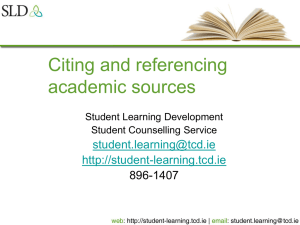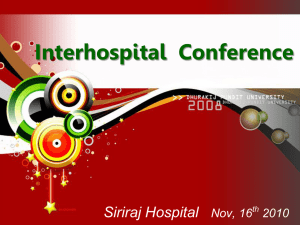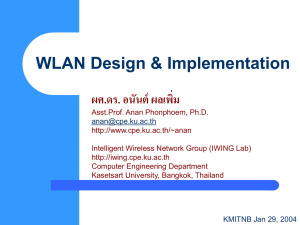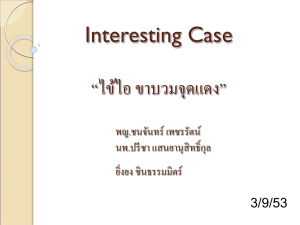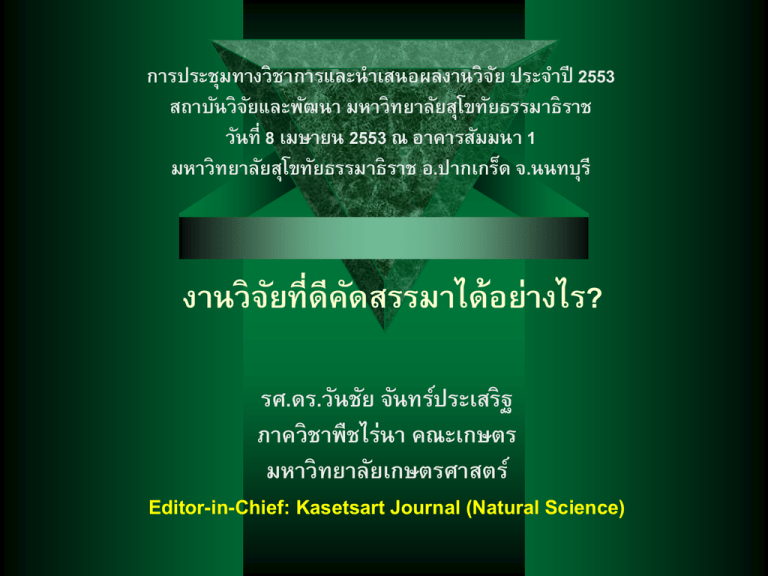
การประชุมทางวิชาการและนาเสนอผลงานวิจยั ประจาปี 2553
สถาบันวิจยั และพัฒนา มหาวิทยาลัยสุโขทัยธรรมาธิราช
วันที่ 8 เมษายน 2553 ณ อาคารสัมมนา 1
มหาวิทยาลัยสุโขทัยธรรมาธิราช อ.ปากเกร็ด จ.นนทบุรี
งานวิจยั ที่ดีคดั สรรมาได้อย่างไร?
รศ.ดร.วันชัย จันทร์ประเสริฐ
ภาควิชาพืชไร่นา คณะเกษตร
มหาวิทยาลัยเกษตรศาสตร์
Editor-in-Chief: Kasetsart Journal (Natural Science)
การคัดสรรงานวิจยั คัดสรรเพื่ออะไร?
เพื่อให้ทุนอุดหนุนการวิจยั
เพื่อให้รางวัล - เชิดชูเกียรติ
วิธีคดั สรรงานวิจยั ที่ดีเพื่อให้ทนุ -ให้รางวัล
กาหนดเกณฑ์ตดั สินให้เหมาะสม รอบคอบ ยุติธรรม
ดาเนินการคัดสรรด้วยกระบวนการที่มีมาตรฐาน โปร่งใส
ปราศจากอคติ และเป็ นที่ยอมรับ
ปัจจัยที่เกี่ยวข้องกับคุณภาพงานวิจยั
งานวิจยั มีที่มาต่างกัน ปัจจัยที่สาคัญได้แก่
– นักวิจยั
– ทุนวิจยั และ
– ปัจจัยแวดล้อมหรือความพร้อมขององค์กรที่นักวิจยั สังกัด
องค์ประกอบของงานวิจยั
– ปัจจัยนาเข้า (Input)
– กระบวนการหรือการดาเนินงานวิจยั (Process)
– ผลงาน (ผลผลิต / outputs)
งานวิจยั ที่ดีคดั สรรมาได้อย่างไร?
ตัวอย่างการกาหนดเกณฑ์ตดั สิน
– ความชัดเจนของการนาเสนอโครงร่างหรือข้อเสนองานวิจยั
– ศักยภาพของงานวิจยั ที่จะมีผลกระทบต่อสังคม
– คุณภาพของการวางแผนและวิธีวิจยั
– ประวัติและเกียรติประวัติของหัวหน้ าโครงการ
– ความเหมาะสมของทุนวิจยั
– แผนการดาเนินงาน และการใช้จ่ายงบประมาณ
– ผลกระทบของโครงการต่อการพัฒนางานวิจยั
(แต่ละข้อมีเกณฑ์กากับการให้คะแนนอย่างชัดเจน)
งานวิจยั ที่ดีคดั สรรมาได้อย่างไร?
การคัดสรรงานวิจยั
ผลงาน (output)
ผลลัพธ์ (outcome)
ผลกระทบ (impact)
งานวิจยั ที่ดีคดั สรรมาได้อย่างไร?
พิจารณาจาก...
– ผลงานวิจยั ที่สงั คมนาไปใช้ประโยชน์
– บทความวิจยั ในวารสารระดับชาติหรือนานาชาติ (วารสารที่
มี JIF) หรือการนาเสนอผลงานในเวทีนานาชาติ (ได้รบั
รางวัลการนาเสนอในการประชุมนานาชาติ)
– ผลงานสร้างสรรค์ หรือสิ่งประดิษฐ์ (สิทธิบตั ร)
วารสารมาตรฐานนานาชาติ
การจัดอันดับวารสารในประเทศไทย
สกอ.
TCI (Thai-Journal Citation Index)
วารสารที่ สกอ. ประกาศให้เป็ น International Journals
1.
2.
3.
4.
5.
6.
7.
8.
9.
10.
11.
12.
13.
ScienceAsia
Songklanakarin Journal of Science and Technology
ECTI Transactions on Electrical Engineering,
Electronics
and Communication (ECTI-EEC)
Thai Journal of Agricultural Science
Asian Pacific Journal of Allergy and Immunology
The Southeast Asian Journal of Tropical Medicine and
Public Health
Journal of the Medical Association of Thailand
Thai Forest Bulletin
Siriraj Hospital Gazette
Asian Biomedicine (Research, Reviews and News)
Asian Journal of Energy and Environment
Journal of Environmental Research
Kasetsart Journal (Natural Science)
เกณฑ์การพิจารณาคุณภาพวารสาร
ออกตรงเวลา
มี peer review
คุณวุฒแิ ละเกียรติประวัตขิ อง editorial board & advisory editorial board
คุณวุฒิและเกียรติประวัติของ reviewer
ขอบเขตการเผยแพร่ และความแพร่ หลายของวารสาร การเข้ าถึง website
แหล่ งทีม่ าของเรื่องที่ลงตีพมิ พ์ ความเป็ นนานาชาติ
การถูกรวมเข้ าใน database ต่ าง ๆ (ที่สาคัญ SCI, SCOPUS)
การถูกอ้ างอิงในวารสารนานาชาติอน
ื่ ๆ (citation)
ฐานข้ อมูลทีจ่ ดั อันดับคุณภาพวารสารด้ วย Impact Factor
Science Citation Index Expanded™ (SCI™ Expanded)
Science Citation Index Expanded is a multidisciplinary index to the
journal literature of the sciences. It fully indexes over 6,650 major
journals across 150 scientific disciplines and includes all cited
references captured from indexed articles.
Some of the disciplines covered include:
Agriculture
Astronomy
Biochemistry
Biology
Biotechnology
Chemistry
Computer Science
Materials Science
Mathematics
Medicine
Neuroscience
Oncology
Pediatrics
Pharmacology
Physics
Plant Sciences
Psychiatry
Surgery
Veterinary Science
Zoology
Institute for Scientific Information (ISI) – Thomson Reauters
Journal Citation Report of ISI
JCR provides quantitative tools for ranking,
evaluating, categorizing, and comparing
journals. The impact factor is one of these;
it is a measure of the frequency with which
the "average article" in a journal has been
cited in a particular year or period.
ต้ องบอกรับเป็ นสมาชิกจึงจะสามารถเข้ าดูผลการจัดอันดับ Impact factor ได้
ขณะนี้ สถาบันที่บอกรับได้ แก่ CU, Mahidol & TU
Impact Factor:
How to calculate?
The impact factor for a journal is calculated based on a three-year
period, and can be considered to be the average number of times
published papers are cited up to two years after publication. For
example, the impact factor 2010 for a journal would be calculated as
follows:
A = the number of times articles published in 2008-9 were cited in
indexed journals during 2010
B = the number of articles, reviews, proceedings or notes published in
2008-2009
impact factor 2010 = A/B
(note that the impact factor 2009 will be actually published in 2010,
because it could not be calculated until all of the 2009 publications had
been received. Impact factor 2010 will be published in 2011)
คิดขืน้ โดย Dr Eugene Garfield ~1996
เปรียบเทียบค่ า JIF ของวารสารวิชาการสาขาต่ างๆ
Discipline
Immunology
Microbiology
Infectious Diseases
Entomology
Food Sci & Tech
Zoology
Veterinary sciences
Agronomy
Agric, Dairy & Anim Sci
Soil Sci
Forestry
Av IF of top-ten journals
16.778
10.578
5.583
3.430
2.958
2.901
2.300
2.023
1.879
1.766
1.725
BMJ 1997;314:497 (15 February)
Why the impact factor of journals should not be used
for evaluating research
Per O Seglen, professor
a
a
Institute for Studies in Research and Higher Education (NIFU) Hegdehaugsveien 31 N-0352
Oslo Norway
Introduction
Evaluating scientific quality is a notoriously difficult problem which has no standard solution.
Ideally, published scientific results should be scrutinised by true experts in the field and given
scores for quality and quantity according to established rules. In practice, however, what is
called peer review is usually performed by committees with general competence rather than
with the specialist's insight that is needed to assess primary research data. Committees tend,
therefore, to resort to secondary criteria like crude publication counts, journal prestige, the
reputation of authors and institutions, and estimated importance and relevance of the research
1
field, making peer review as much of a lottery as of a rational process.
2 3
On this background, it is hardly surprising that alternative methods for evaluating research are
being sought, such as citation rates and journal impact factors, which seem to be quantitative
and objective indicators directly related to published science. The . . . [Full text of this article]
Is the journal impact factor really
representative of the individual journal
articles?
Relation of journal impact factor and citation rate of article
Journal impact factors are calculated in a way that causes bias
Limitations of the database
Journal impact factors depend on the research field
Is the impact of an article increased by
publication in a high impact journal?
ความคิดเห็น ต่อค่า IF
- ขึน้ อยู่กบั res field
- อาจไม่เป็ นธรรมชาติ
- เป็ นการนับเชิงปริมาณ
- วารสารที่ดี มีคณ
ุ ภาพ
สูงและได้รบั การยอมรับ
อย่างสูง อาจมีค่า IF ตา่
ก็ได้ โดยเฉพาะอย่างยิ่ง
วารสารวิชาการเฉพาะ
ทาง
ฐานข้อมูลนานาชาติที่จดั อันดับวารสารวิชาการ
และดัชนี การอ้างอิงวารสารวิชาการนานาชาติ
ฐานข้อมูลนานาชาติ
SCI
ค่าดัชนี ชี้วดั คุณภาพวารสาร
-> ค่า JIF (journal impact factor)
SCOPUS
-> ค่า SJR, SNIP
Harzing’s Publish or Perish -> h-index, g-index etc.
ERA
-> Grade A*, A, B, C
การจัดอันดับวารสารนานาชาติของ SCOPUS
ค่ า SJR และค่ า SNIP
Scopus® is a registered trademark of
Elsevier B.V.
Copyright © 2010 Elsevier B.V.
All rights reserved.
Kasetsart Journal (Natural Science) มี SJR = 0.036
Kasetsart Journal (Social Sciences) มี SJR = 0.034
Kasetsart Journal (Natural Science) มี SNIP = 0.067
Kasetsart Journal (Social Sciences) มี SNIP =
การสืบค้นการอ้างอิงของวารสารนานาชาติ
ในฐานข้อมูล Harzing’s Publish or Perish
พิมพ์ Kasetsart Journal
Journal impact analysis
ฐานข้ อมูล
The Excellence in
Research for
Australia
ERA
The Excellence in Research for
Australia (ERA) Initiative
On 26 February 2008, the Minister for Innovation, Industry, Science and
Research, the Hon. Senator Kim Carr, announced his plans for a new research
quality and evaluation system.
The Excellence in Research for Australia (ERA) initiative assesses research
quality within Australia's higher education institutions using a combination of
indicators and expert review by committees comprising experienced,
internationally-recognised experts.
ERA uses leading researchers to evaluate research in eight discipline clusters.
ERA will detail areas within institutions and disciplines that are internationally
competitive, as well as point to emerging areas where there are opportunities
for development and further investment.
A 2009 trial of ERA evaluated the Physical, Chemical and Earth Sciences (PCE)
and Humanities and Creative Arts (HCA) clusters, and informed the full 2010
process.
The national report for both these trials is now available.
Rank Interpretation
A*
– Best or leading journal in its field - publishes outstanding, original and rigorous
research that will shape the field. Acceptance rates are typically low and the editoria
lboard is dominated by leading scholars in the field or subfield, including
from top institutions in the world. Where relevant to the field or subfield, the journal
has the highest impact factors or other indices of high reputation.
A
– Highly regarded journal in the field or subfield - publishes excellent research in
terms of originality, significance and rigour, has competitive submission and acceptance
rates, excellent refereeing process and where relevant to the field or
subfield, has higher than average impact factors. Not all highly regarded journals
have high impact factors, especially those in niche areas.
B
– Well regarded journal in the field or subfield - publishes research of a good standard
in terms of originality, significance and rigour and papers are fully refereed
according to good standards and practices but acceptance rates are higher than
for Tiers A* and A. Depending on the field or sub-field, will have a modest impact
factor and will be ISI listed.
C
– A recognised journal - publishes research that is of a modest standard and/or is
งานวิจยั ทีด่ ี - คัดสรรเพือ่ ตีพิมพ์ใน
วารสารวิชาการทีม่ ีคณ
ุ ภาพ
งานวิจยั ที่มีคุณภาพ
Originality
วัตถุประสงค์ ชดั เจน
ค้นคว้าและตรวจเอกสารงานวิจยั ครอบคลุมทัว่ ถึง
วางแผนทางสถิตถิ ูกต้องและเหมาะสม
วิธีวจิ ัยถูกต้องและสุ่ มเก็บข้อมูลเหมาะสม
วิเคราะห์ และแปลผลถูกต้อง
ลักษณะที่ดีของบทความวิจยั
ชื่อเรื่อง : ชัดเจน เข้าใจง่าย ครอบคลุมขอบข่ายของปัญหาที่ศึกษา
ความเป็ นมา : อธิบายถึงปัญหาอย่างชัดเจน บอกเจตนาและเหตุผลของการวิจยั
กล่าวถึงรากฐานทางทฤษฎีของงานวิจยั และงานวิจยั ที่เกี่ยวข้อง
วัตถุประสงค์งานวิจยั : ชัดเจนและครอบคลุม
วิธีวิจยั : มีรายละเอียด รัดกุม ระบุจานวนและขนาดตัวอย่าง การวางแผนงานทาง
สถิติที่เหมาะสม
ผล : ลาดับเนื้ อหาเหมาะสม แสดงผลทางสถิติ ตาราง รูป มีคาอธิบายได้ครอบคลุม
อ่านเข้าใจได้รวดเร็ว ชี้ประเด็นสาคัญของผลการวิจยั
วิจารณ์ : อภิปรายในประเด็นสาคัญต่าง ๆ กล่าวอ้างเปรียบเทียบกับงานวิจยั ที่ผา่ นมา
สรุป : สรุปผลการทดลองในประโยคหรือย่อหน้ าท้ายของวิจารณ์ หรือผลและวิจารณ์
ผลงานวิจยั สาเร็จสมบูรณ์
ตีพิมพ์ในวารสารนานาชาติ
การคัดสรรงานวิจยั ที่ดีจากผลงานตีพิมพ์
การคัดสรรงานวิจยั ที่ดีจากผลงานตีพิมพ์
การคัดสรรงานวิจยั ที่ดีจากผลงานตีพิมพ์
การคัดสรรงานวิจยั ที่ดีจากผลงานตีพิมพ์




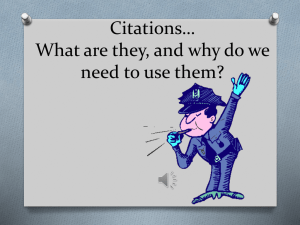
![DBQ Citations [Direct and Indirect]](http://s2.studylib.net/store/data/005429647_1-368ff05a656398a459c47105833e4c53-300x300.png)

